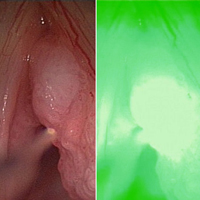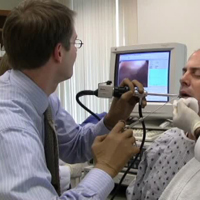Recurrent Respiratory Papillomatosis Program
Contact Information
Recurrent Respiratory Papillomatosis Program
Center for Laryngeal Surgery and Voice Rehabilitation
One Bowdoin Square, Floor 11
Boston,
MA
02114
Phone: 617-726-1444
Fax: 617-726-0222
Email: Voice_Center_2@partners.org
Explore This Program
About This Program
Physicians in Massachusetts General Hospital's Voice Center offer a comprehensive range of treatments for recurrent respiratory papillomatosis (RRP).
About the Condition
Papilloma is a non-cancerous, warty growth that can affect the vocal cords as well as other parts of the voice box and airway, resulting in hoarseness and breathing problems. Although the growth can be removed, it often recurs, despite surgery, on account of the causative virus being harbored in nearby cells that look normal, and the disease is therefore known as recurrent respiratory papillomatosis (RRP).
When aggressive recurrent disease is encountered, the surgeon and patient must delicately balance airway safety and the effects of multiple general anesthetics, as well as quality of life and employment disturbance resulting from vocal dysfunction and procedural disability.
Currently, there is no cure for RRP, but the following pioneering management strategies for this chronic disease have been introduced by the Mass General Voice Center team.
Potassium Titanyl Phosphate (KTP) Laser

Surgical excision is usually the treatment of choice for RRP. We do not use the carbon dioxide laser or microdebriders because these devices are more likely to cause injury to the delicate vocal membranes. Although these technologies allow for faster procedures, they are substantially less precise, and as a result, we are now treating a large number of patients who have sustained permanent vocal cord scarring from them at other institutions.
We performed the first large-scale investigation using the yellow light pulsed-dye laser (PDL) for RRP. Recently, we introduced the green-light pulsed KTP laser—which is substantially more effective than the PDL—as a reliable means of treating papilloma while minimizing vocal scarring.
In our experience, the KTP laser is a superior surgical tool compared to other forms of surgical treatment for RRP.
Office-based Laser Treatment
In 2001, we revolutionized the management of RRP patients by introducing office-based laser treatments, negating the need for repeated general anesthesia. We have had a number of patients who have previously undergone over 100 procedures in the operating room at other institutions, prior to transferring their care to us. While operative management with the pulsed-KTP laser under general anesthesia remains an integral part of our initial papilloma treatment process, it is highly unusual for our RRP patients to require ongoing surgical procedures in the operating room, since the majority of their recurrences can be managed in the office. Remarkably, this critical advancement has yet to be provided to most patients in the United States and overseas.
Laryngeal Bevacizumab (Avastin)

In 2008, we pioneered the localized use of bevacizumab (Avastin), a drug that reduces the growth of new blood vessels, to prevent recurrence of laryngeal papillomatosis and published the successful results of this pilot study in 2009. We observed that following initial operating-room surgical management, almost all patients can be injected with bevacizumab into the vocal cords and other parts of the larynx in the office, substantially delaying the recurrence of the disease.
We have even observed isolated cases of complete disease remission.
In cooperation with the Food and Drug Administration (FDA), we completed a prospective, controlled study to further investigate this exciting new management strategy for RRP. It is important for patients and their families to know that while this bevacizumab investigation was being done, the Voice Center group could not treat other patients outside of the clinical trial.
Now, however, we have been cleared to treat all adult patients and selected pediatric patients due to the great clinical success of bevacizumab and the KTP laser over the past two years and the fact that we had no complications associated with more than 200 laryngeal bevacizumab injections.
Examples of Patients Before and After Treatment
Video of Laryngeal Recurrent Respiratory Papillomatosis
Video of Laryngeal Recurrent Respiratory Papillomatosis in a professional opera singer
Video of Laryngeal Recurrent Respiratory Papillomatosis
Video of Laryngeal Recurrent Respiratory Papillomatosis
#1 Research Hospital in America
Mass General is recognized as a top hospital on the U.S. News Best Hospitals Honor Roll for 2023-2024.
Contact Us to Learn More
Physicians in Massachusetts General Hospital's Voice Center offer a comprehensive range of treatments for recurrent respiratory papillomatosis (RRP) of the larynx.
